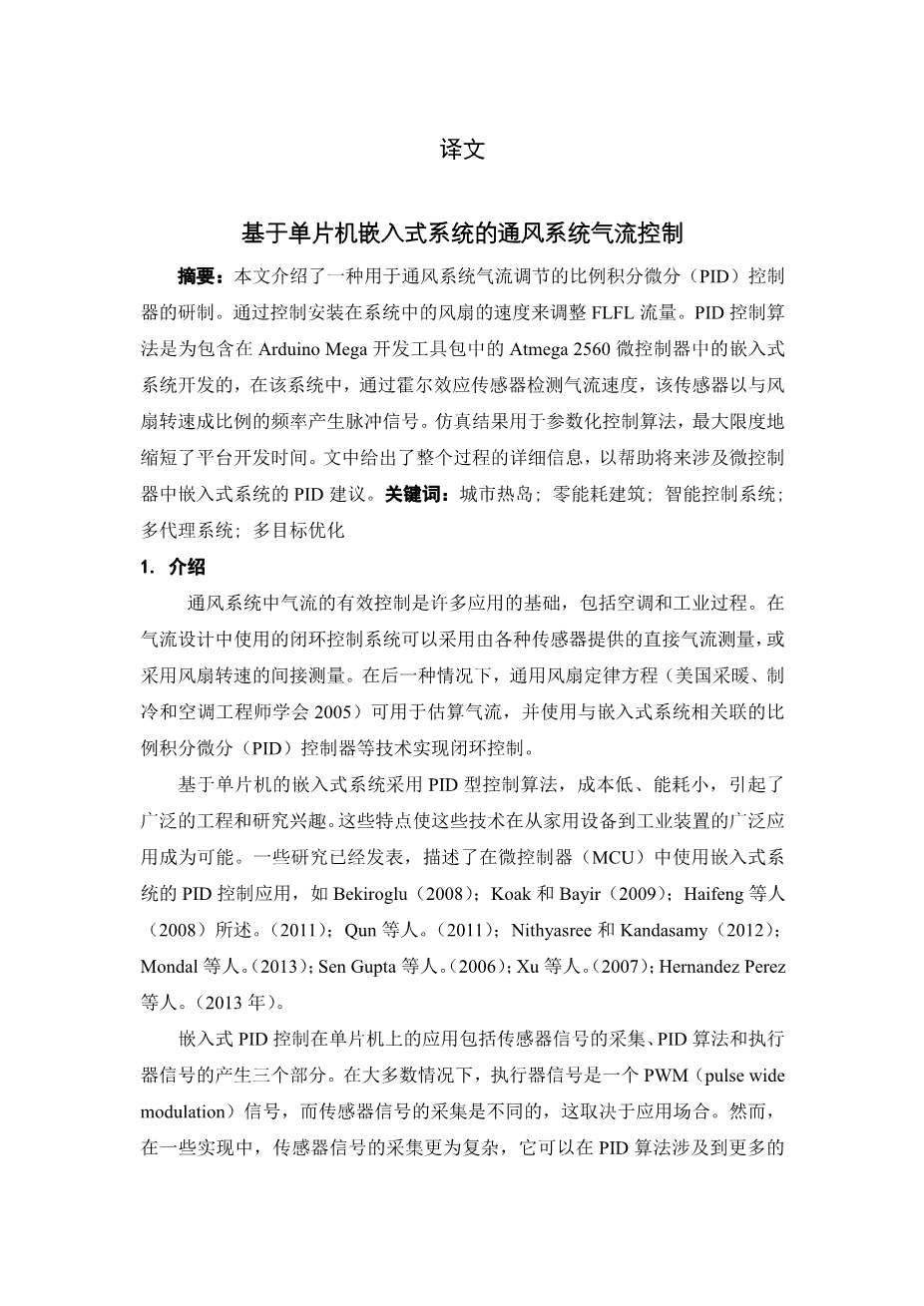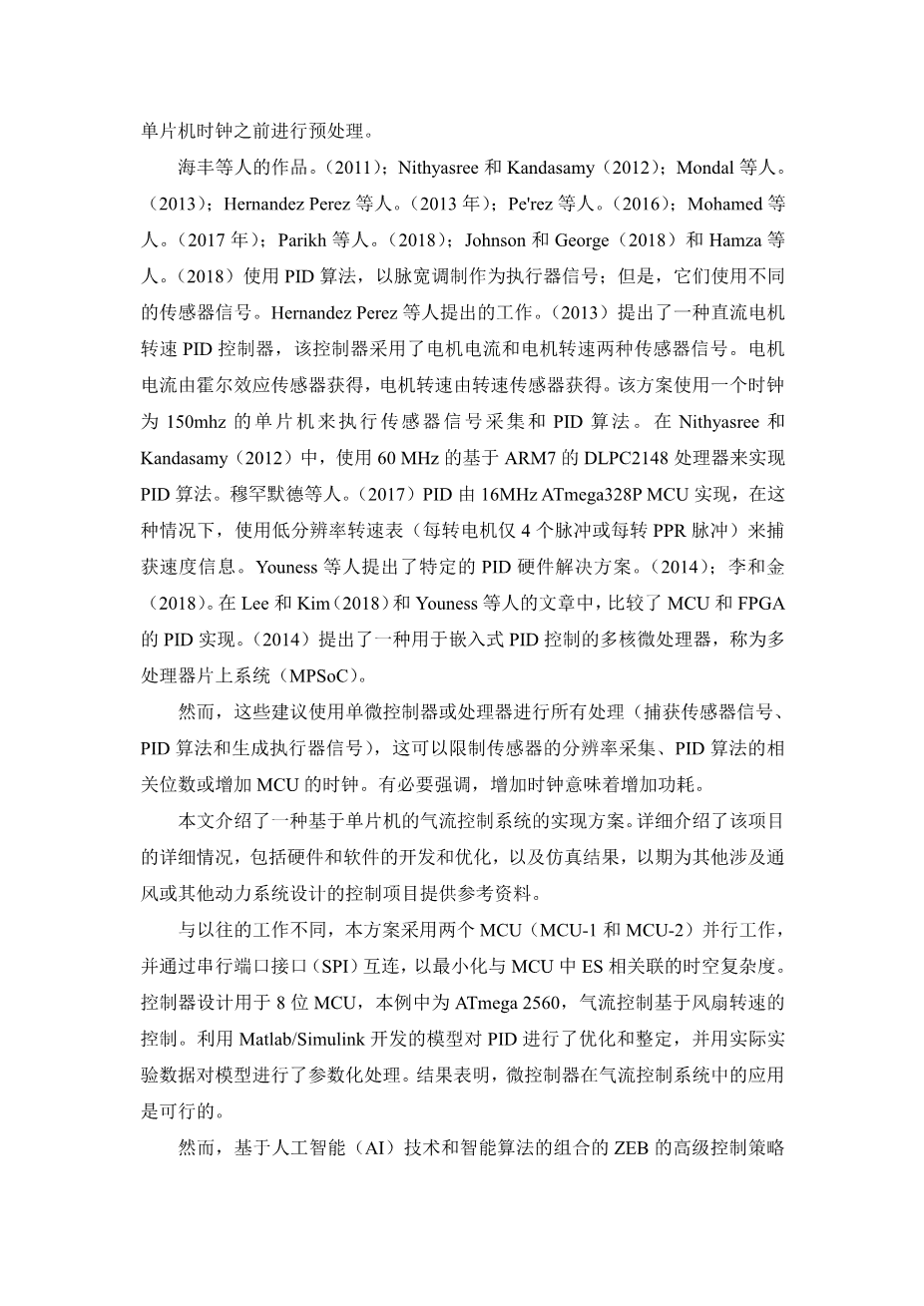Control of airflow in ventilation systems using embedded systems on microcontrollers
Abstract: This paper describes the development of a proportional-integral-derivative (PID) controller for regulation of the airflflow in a ventilation system. The flflow was adjusted by controlling the speed of the fan installed in the system. The PID control
algorithm was developed for an embedded system in an Atmega 2560 microcontroller contained in an Arduino Mega development kit, where the airflflow rate was detected by a Hall-effect sensor that generated a pulsed signal at a frequency proportional to the speed of the fan. Simulation results were used to parameterize the control algorithm, minimizing the benchtop development time. Full details of the procedure are presented in order to assist future PID proposals involving embedded systems in microcontrollers.
1. Introduction
Effective control of airflflow in ventilation systems is fundamental in many applications, including air-conditioners and industrial processes. Closed-loop control systems used in airflflow designs can employ direct flflow measurements provided by various types of sensors, or indirect measurements that employ the speed of the fan. In the latter case, general fan law equations (American Society of Heating, Refrigerating and Air-Conditioning Engineers 2005) can be used to estimate the airflflow and implement closed-loop control using techniques such as proportionalintegral-derivative (PID) controllers associated with embedded systems (ES).
The use of PID-type control algorithms on microcontroller based embedded systems has stimulated considerable engineering and research interest, due to the low cost and small energy consumption of this type of hardware. These features make it feasible to use such techniques in a wide range of applications ranging from domestic equipment to industrial installations. Several studies have been published describing PID control applications that employembedded systems in microcontrollers (MCUs) as presented in Bekiroglu (2008); Koak and Bayir (2009); Haifeng et al. (2011); Qun et al. (2011); Nithyasree and Kandasamy (2012); Mondal et al. (2013); Sen Gupta et al. (2006); Xu et al. (2007); Hernandez-Perez et al. (2013).
The PID control embedded applications on MCUs involve three parts: the capturing of the sensor signal, the PID algorithm and the generation of actuator signal. In most cases, the actuator signal is a PWM (pulse wide modulation) signal, and the sensor signal acquisition is different, and it depends on the application. Nevertheless, in some implementations, the sensor signal acquisition is more complex, and it can order a pre-processing before the PID algorithm involving more clock from the MCU.
The work presented in Hai-feng et al. (2011); Nithyasree and Kandasamy (2012); Mondal et al. (2013); Hernandez-Perez et al. (2013); Peacute;rez et al. (2016); Mohamed et al. (2017); Parikh et al. (2018); Johnson and George (2018) and Hamza et al. (2018) use the PID algorithm with PWM as actuator signal; however, they use different sensors signals. The work presented in Hernandez-Perez et al. (2013) proposed a PID controller to speed of the DC motor, and it used two sensor signals: the motor current and motor speed. The motor current was obtained by the hall effect sensor, and the motor speed used a tachometer sensor. The proposal used an MCU with a clock of the 150 MHz to execute the sensor signal acquisition and PID algorithm. In Nithyasree and Kandasamy (2012) the ARM7 basedLPC2148 processor with 60 MHz is used to implement a PID algorithm. In Mohamed et al. (2017) the PID is implemented with 16 MHz ATmega328P MCU, and in this case, the low-resolution tachometer (just four pulses per motor rotate or pulses per revolution—PPR) is used to capture the speed information. Specifific PID hardware solutions are presented in Youness et al. (2014); Lee and Kim (2018). The comparison between MCU and FPGA about PID implementation is shown in Lee and Kim (2018), and in Youness et al. (2014) multicore microprocessor called multiprocessor system-on-chip (MPSoC) to embedded PID control is proposed.
However, these proposed use the single microcontroller or processor for all processing (capturing of the sensor signal, the PID algorithm, and the generation of actuator signal) and this can limit the resolution acquisition of the sensor, the number the bits associated of the PID algorithm or increase the clock of the MCU. It is necessary to emphasize that increase the clock implies increase the power consumption.
The present work describes a proposal for the implementation of an airflflow control system embedded in an MCU. Full details of the project are described, including hardware and software development and optimization, as well as simulation results, in order to provide a reference material for other control projects involving the design of ventilation or other dynamic systems.
Different to previous work, this proposal employed two MCUs (MCU-1 and MCU-2), functioning in parallel and interconnected by a serial port interface (SPI), in order to minimize the spatial and temporal complexity associated with the ES in the MCU. The controller was designed for use with an 8-bit MCU, in this case an ATmega 2560, and the airflflow control was based on control of the fan speed. Optimization and tuning of the PID was performed using a model developed in Matlab/Simulink, which was parameterized with real experimental data. The results demonstrated the viability of using microcontrollers in airflflow control systems.
2 System architecture
Figure 1 presents the airflflow system used in this project. A fan, V1, generated an airflflow, q(t), measured in cubic feet per minute (CFM), through a duct of length l meters (m). The fan, V1, was coupled to a direct current (DC) motor, MT1, which operated at
剩余内容已隐藏,支付完成后下载完整资料


英语译文共 21 页,剩余内容已隐藏,支付完成后下载完整资料
资料编号:[606829],资料为PDF文档或Word文档,PDF文档可免费转换为Word


